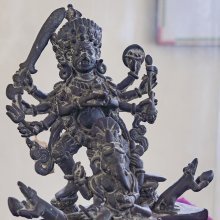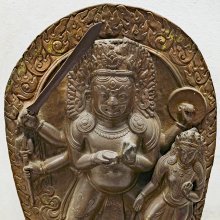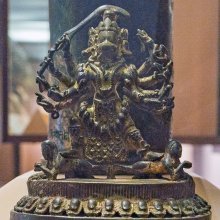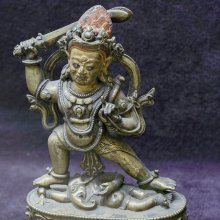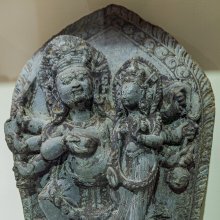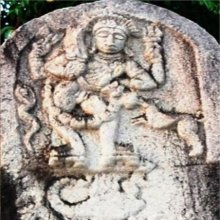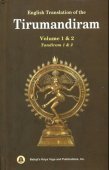Bhairava: 37 definitions
Introduction:
Bhairava means something in Buddhism, Pali, Hinduism, Sanskrit, Jainism, Prakrit, Marathi, Hindi. If you want to know the exact meaning, history, etymology or English translation of this term then check out the descriptions on this page. Add your comment or reference to a book if you want to contribute to this summary article.
Alternative spellings of this word include Bhairav.
Images (photo gallery)
(+44 more images available)
In Hinduism
Purana and Itihasa (epic history)
Source: archive.org: Puranic Encyclopedia1) Bhairava (भैरव).—A nāga belonging to the Dhṛtarāṣṭra Vaṃśa. There is a reference to this nāga in Mahābhārata, Ādi Parva, Chapter 51, Verse 17. He was burnt up at the Sarpasatra performed by King Janamejaya. (See full article at Story of Bhairava from the Puranic encyclopaedia by Vettam Mani)
2) Bhairava (भैरव).—A Pārṣada of Śiva. General. Immediately after his birth, this terrible monster subdued all the Devas without getting the permission of Śiva. Enraged at it, Śiva turned him into a tree by a curse. But Śiva was soon pacified and lifted the curse by declaring that those who offered pūjā to the gods would get the full reward for their worship only if they offered pūjā to Bhairava also.
Source: archive.org: Shiva Purana - English Translation1) Bhairava (भैरव) is one of the deities associated with a “Rudraksha with eight faces” (Aṣṭavaktra), according to the Śivapurāṇa 1.25, while explaining the greatness of Rudrākṣa:—“[...] a Rudrākṣa with eight faces (aṣṭavaktra) is called Vasumūrti and Bhairava. By wearing it a man lives the full span of life. After death he becomes the Trident-bearing lord (Śiva)”.
Bhairava is also associated with a “Rudraksha with nine faces” (Navavaktra):—“[...] a Rudrākṣa with nine faces (navavaktra) is also Bhairava. Its sage is Kapila. Its presiding goddess is Durgā of nine forms, Maheśvarī Herself”.
2) Bhairava (भैरव) refers to a group of deities who together with the nine Durgās participated in Vīrabhadra’s campaign against Dakṣa, according to the Śivapurāṇa 2.2.33. Accordingly, as Brahmā narrated to Nārada:—“Mahākālī went ahead for the destruction of Dakṣa accompanied by nine Durgās [...]. Eager in executing the command of Śiva, they accompanied the marching heroes—[viz., Bhairavas] and set out quickly for the destruction of Dakṣa’s sacrifice”.
3) Bhairava (भैरव) refers to an epithet of Śiva, according to the Śivapurāṇa 2.2.41.—Accordingly, as Viṣṇu and others eulogized Śiva:—“[...] obeisance to the great lord, greater than the greatest, the greatest of the great, the all-pervading omniformed lord. Obeisance to Viṣṇukalatra, Viṣṇukṣetra, the sun, Bhairava, the refuge of the refugees, the three-eyed and the sportive”.
Source: Cologne Digital Sanskrit Dictionaries: The Purana Index1a) Bhairava (भैरव).—A Śiva gaṇa.*
- * Brahmāṇḍa-purāṇa III. 41. 27; IV. 14. 7; 17. 4; 19. 78-9; 33. 17.
1b) An epithet of Rudra; the form assumed by Śiva when Gaurī returned from penance; She became Bhairavī;1 Image of, to be placed in each temple but not in mūlāyantana.2
1c) A tīrtha on the banks of Carmanvatī sacred to the Pitṛs.*
- * Matsya-purāṇa 22. 31.
1d) tapas performed by Brahmā.*
- * Vāyu-purāṇa 26. 10.
1e) An Apsarasa clan from Mṛtyu.*
- * Vāyu-purāṇa 69. 57.
Bhairava (भैरव) is a name mentioned in the Mahābhārata (cf. I.52.15, I.57) and represents one of the many proper names used for people and places. Note: The Mahābhārata (mentioning Bhairava) is a Sanskrit epic poem consisting of 100,000 ślokas (metrical verses) and is over 2000 years old.
Source: Shodhganga: The saurapurana - a critical studyBhairava (भैरव) guarded Mandara mountain where Pārvatī was residing and eventually killed the demon Andhaka, according to the 10th century Saurapurāṇa: one of the various Upapurāṇas depicting Śaivism.—Accordingly, “[...] In order to enjoy Śarvāṇī (Pārvatī) Andhaka proceeded to Mandara mountain. For some reason Śiva had gone to beg alms with the Brāhmaṇas and placed Pārvatī on the Mandara. Gods assuming the forms of women were in the service of the goddess. The Lord ordered Nandī and Bhairava to guard. When the demon approached Kālabhairava hit him with his dart (śūla). A battle ensued between Bhairava and Andhaka. Viṣṇu who was in the female form and was employed in the service of Pārvatī, created a hundred goddesses and tried to get Andhaka killed through them. Hearing the news Śiva in the mean time arrived at Mandara and ordered Bhairava to kill Andhaka. Bhairava having pierced the demon at the edge of the dart danced”.
Note: Bhairava is described sometimes as the form of Śiva himself and sometimes as a powerful person produced from his body. For other details about Bhairava See Agnipurāṇa 52.9-11; Śivapurāṇa 1.8.1 and 3.21.2-11; Kūrmapurāṇa 2.31.69-71.

The Purana (पुराण, purāṇas) refers to Sanskrit literature preserving ancient India’s vast cultural history, including historical legends, religious ceremonies, various arts and sciences. The eighteen mahapuranas total over 400,000 shlokas (metrical couplets) and date to at least several centuries BCE.
Shilpashastra (iconography)
Source: Wisdom Library: Śilpa-śāstraBhairava (भैरव) is a manifestion of Śiva. According to the Rudrayāmala, there are eight main forms of Bhairava who control the eight directions of this universe. The term is used throughout Śilpaśāstra literature.
The eight forms of Bhairava are:
- Asitāṅga,
- Ruru,
- Caṇḍa,
- Krodha,
- Unmatta,
- Kāpāla,
- Bhīṣaṇa,
- Saṃhāra.
Each of these forms has eight emanations thus totalling to sixty-four Bhairavas.
Source: Google Books: Elements of Hindu iconographyBhairava (भैरव).—(According to the Śilparatna), in the aspect of Bhairava, Śiva has eighteen arms; the additional hands hold the ḍamaru and the śaṅkha. In the instance [of sixteen arms], the following six objects should be carried in addition to those mentioned in connection with the image of Siva with ten arms; namely, the bāṇa, the cakra and the gadā in the right hands and the bow, a bell and the śaṅkha in the left hands. When Śiva has ten arms, the right hands should carry an akṣamālā, a sword, the śaktyayudha, the daṇḍa and the śūla; whereas the left hands should carry the khaṭvāṅga, a snake, a skull, the kheṭaka and the deer.
Source: Shodhganga: The significance of the mūla-beras (śilpa)Bhairava (भैरव) is the name of a deity depicted at the Nellaiappar Temple at Tirunelveli, representing a sacred place for the worship of Śiva.—[...] in the right corner is the sanctum of Bhairava. Bhairava is found to be in digāṃbara form (clothed in sky). His dog accompanies him. The dog is an incarnation of Kuṇḍodara (Kuṇḍōdaran) (he who carries Śiva’s umbrella). Bhairava is represented as standing in samapāda-sthānaka in samabhaṅga with four hands. The upper right hand holds uḍukkai (drum) with sarpa (snake) on it and pāśa in the upper left hand in kaṭaka-hasta. The lower right hand holds śūla (trident) and the lower left hand holds kapāla (Brahmā’s skull) in kaṭaka-hasta and siṃhakarṇa/vismaya-hasta. His scarf is a necklace of skulls. The basic measurement for making the image of Śiva is covered by uttama-daśatāla.
While depicting in Bharatanatyam, Bhairava is represented in samapāda-sthānaka with the two upper hands holding kapittha-hasta and the lower right hand holding the trident and the lower left hand holding kapāla in kapittha and siṃhamukha opened/kuvi-patāka/alapadma-hasta. There is a sannidhi for Cokkarliṅga where the liṅga is found with Nandi in front of the liṅga and the deity Pārvatī to the left of the liṅga in her usual form.
Bhairava is also depicted in the Meenakshi Temple in Madurai (or Madura), which represents a sacred place for the worship of The Goddess (Devī).—Bhairava is represented with four hands where the upper right hand holds the kettle-drum in kaṭaka and the upper left hand holds the noose in kaṭaka, while the lower right hand has the trident in kaṭaka-hasta and the lower left hand has the cup or skull in pallava-hasta. He is represented as standing. While depicting in dancing techniques, he is represented with the upper two hands in kaṭaka-hasta and the lower right hand in kapittha-hasta and the lower left hand in kuvi-patāka or siṃhamukha opened with fingers slightly bent.
Bhairava is also depicted in the Subramanya Swamy Temple (or Subrahmaṇya Svāmi Temple) in Tiruchendur (or Tirucendur/Tirucentur), representing a sacred place for the worship of Murugan.—Bhairava is found in standing posture in samabhaṅga with four hands. The upper right hand holds aṅkuśa and the upper left hand holds antelope in kaṭaka-hasta. The lower right hand holds triśūla in kaṭaka-hasta and the lower left hand holds kapāla in vismaya-hasta. A dog is found behind the icon of Bhairava. Then there is the sannidhi for the dancing Naṭarāja in his usual form. Pārvatī is found to the left of the dancing Naṭarāja and a sage is found to the right.

Shilpashastra (शिल्पशास्त्र, śilpaśāstra) represents the ancient Indian science (shastra) of creative arts (shilpa) such as sculpture, iconography and painting. Closely related to Vastushastra (architecture), they often share the same literature.
Shaivism (Shaiva philosophy)
Source: Wisdom Library: ŚaivismBhairava (भैरव) is a Sanskrit word referring to one of the sixty-eight places hosting a svāyambhuvaliṅga, one of the most sacred of liṅgas according to the Śaivāgamas. The presiding deity residing over the liṅga in this place (Bhairava) is similarly-named Bhairava. The list of sixty-eight svāyambhuvaliṅgas is found in the commentary of the Jirṇoddhāra-daśaka by Nigamajñānadeva. The word liṅga refers to a symbol used in the worship of Śiva and is used thoughout Śaiva literature, such as the sacred Āgamas.
Source: SOAS University of London: Protective Rites in the Netra TantraBhairava (भैरव) is the name of a deity who “burns up and dissolves all things”, according to the Netratantra of Kṣemarāja: a Śaiva text from the 9th century in which Śiva (Bhairava) teaches Pārvatī topics such as metaphysics, cosmology, and soteriology.—Accordingly, [verse 10.1-7ab, while describing the appearance and worship of Bhairava]—“Now, at this moment, I shall explain the distinct appearance of Bhairava, [who] resembles an ointment [that clears the eye]. He has a nature that burns up and dissolves all things. Five-faced, atop a corpse, ten-armed [and] terrible, he resembles troops with demon mouths. He rumbles, [producing] a terrible noise, speaks with a gaping mouth [adorned with] with large tusks, [his face] bent in a frown. [...] Having worshipped Bhairava, [the Mantrin] remembers being joined in union [with] him, [in the same way as] dissolution in fire”.
Note: In 9.5-11, Bhairava is equated with Amṛteśa: “Amṛteśa is supreme. He is free of disease. [...] Because of him, splendid gems light up [differently] under different conditions, giving the fruits of all Āgamas in all streams. Thus, he is Śiva, Sadāśiva, Bhairava, Tumburu, Soma, and Sūrya, with his own form arising bearing no form”.

Shaiva (शैव, śaiva) or Shaivism (śaivism) represents a tradition of Hinduism worshiping Shiva as the supreme being. Closely related to Shaktism, Shaiva literature includes a range of scriptures, including Tantras, while the root of this tradition may be traced back to the ancient Vedas.
Vastushastra (architecture)
Source: Shodhganga: Temples of Salem region Up to 1336 ADBhairava (भैरव).—Bhairava, according to tradition is considered as the kṣetrapāla. Therefore his sculptures are found generally in almost in all the temples. In the forms of Bhairava of the region different varieties are discemable. They are four-handed, eight-handed, and sixteen-handed Bhairavas. These Bhairava sculptures except three are in sthānaka posture, while three are in āsīna posture. Iconographically, they may be identified as vāṭuka, kṣetrapāla and aghora Bhairavas.

Vastushastra (वास्तुशास्त्र, vāstuśāstra) refers to the ancient Indian science (shastra) of architecture (vastu), dealing with topics such architecture, sculpture, town-building, fort building and various other constructions. Vastu also deals with the philosophy of the architectural relation with the cosmic universe.
Nirukta (Sanskrit etymology)
Source: Google Books: Manthanabhairavatantram (etymology)Bhairava (भैरव) is derived from three roots—bhṛ, ram and vam in the sense of filling or sustaining, sporting and emitting, respectively. Bhairavī’s name is derived in a similar way in the Kubjikā sources.
Source: archive.org: Vijnana Bhairava or Divine Consciousness (etymology)Bhairava (भैरव) esoteric meaning according to Kṣemarāja in his Udyota commentary.—The sum and substance of it is that Bhairava is an acrostic word consisting of the letters, bha, ra and va;—(1) bha indicates bharaṇa or maintenance of the universe; (2) ra indicates ravaṇa or withdrawal of the universe; (3) va indicates vamana or projection i.e., manifestation of the universe.—Thus Bhairava indicates all the three aspects of the Divine.
Nirukta (निरुक्त) or “etymology” refers to the linguistic analysis of the Sanskrit language. This branch studies the interpretation of common and ancient words and explains them in their proper context. Nirukta is one of the six additional sciences (vedanga) to be studied along with the Vedas.
Pancaratra (worship of Nārāyaṇa)
Source: Wisdom Library: PāñcarātraBhairava (भैरव) refers to an aspect of nṛsiṃha (‘man-lion’), according to the Vihagendra-saṃhitā 4.17, which mentions seventy-four forms (inlcuding twenty forms of vyūha). He is also known as Bhairavanṛsiṃha or Bhairavanarasiṃha. Nṛsiṃha is a Tantric deity and refers to the furious (ugra) incarnation of Viṣṇu.
The 15th-century Vihagendra-saṃhīta is a canonical text of the Pāñcarātra corpus and, in twenty-four chapters, deals primarely with meditation on mantras and sacrificial oblations.

Pancaratra (पाञ्चरात्र, pāñcarātra) represents a tradition of Hinduism where Narayana is revered and worshipped. Closeley related to Vaishnavism, the Pancaratra literature includes various Agamas and tantras incorporating many Vaishnava philosophies.
Shaktism (Shakta philosophy)
Source: Google Books: Manthanabhairavatantram1) Bhairava (भैरव) or Bhairavavrata refers to the “vow of Bhairava”, according to the Brahmayāmala verse 21.1-4ab.—Accordingly, “Next I will explain the vows born from Ucchuṣma (Bhairava). The Vow of Nakedness is one. The second is (the vow of wearing) rags. The third one is the one of impurity. The fourth is (the Vow of) Madness. The sixth one is said to be the one of the skull. The sixth one is said to be (the Vow of) Bhairava [i.e., bhairava-vrata]. The seventh is called the (vow of behaving like a) child. The eighth is (the vow of) eating meat. The ninth is the (vow of) growth, which gives all accomplishments. These are said to be the nine Vows that belong to the Vidyā division”.
2) Bhairava (भैरव) or Bhairavamantra refers to the Mantra associated with Tisra, one of the eight Sacred Seats (pīṭha), according to the Yogakhaṇḍa (chapter 14) of the Manthānabhairavatantra, a vast sprawling work that belongs to a corpus of Tantric texts concerned with the worship of the goddess Kubjikā.
Source: DSpace at Pondicherry: Siddha Cult in Tamilnadu (shaktism)Bhairava (भैरव).—The male deities in Śaktism are called Bhairavas. Śiva is also a Bhairava. But he being the Puruṣa of Śakti his position is different from them. In reference to the deities the Tantras can be classified as Śakti, Śiva and Bhairava.
Source: Shodhganga: Iconographical representations of Śiva (shaktism)Bhairava (भैरव) or Bhairavatantra refers to one of the thirty-three Dakṣiṇatantras, belonging to the Śāktāgama (or Śāktatantra) division of the Āgama tradition. The Śāktāgamas represent the wisdom imparted by Devī to Īśvara and convey the idea that the worship of Śakti is the means to attain liberation. According to the Pratiṣṭhālakṣaṇasamuccaya of Vairocana, the Śāktatantras are divided into to four parts, the Bhairava-tantra belonging to the Dakṣiṇa class.

Shakta (शाक्त, śākta) or Shaktism (śāktism) represents a tradition of Hinduism where the Goddess (Devi) is revered and worshipped. Shakta literature includes a range of scriptures, including various Agamas and Tantras, although its roots may be traced back to the Vedas.
Ayurveda (science of life)
Rasashastra (Alchemy and Herbo-Mineral preparations)
Source: Wisdom Library: Rasa-śāstraBhairava (भैरव) or Bhairavarasa is the name of an Ayurvedic recipe defined in the fifth volume of the Rasajalanidhi (chapter 5, Svarabheda: hoarseness). These remedies are classified as Iatrochemistry and form part of the ancient Indian science known as Rasaśāstra (medical alchemy). However, since it is an ayurveda treatment it should be taken with caution and in accordance with rules laid down in the texts.
Accordingly, when using such recipes (e.g., bhairava-rasa): “the minerals (uparasa), poisons (viṣa), and other drugs (except herbs), referred to as ingredients of medicines, are to be duly purified and incinerated, as the case may be, in accordance with the processes laid out in the texts.” (see introduction to Iatro chemical medicines)
Unclassified Ayurveda definitions
Source: gurumukhi.ru: Ayurveda glossary of termsBhairava (भैरव):—Bizzare look

Āyurveda (आयुर्वेद, ayurveda) is a branch of Indian science dealing with medicine, herbalism, taxology, anatomy, surgery, alchemy and related topics. Traditional practice of Āyurveda in ancient India dates back to at least the first millenium BC. Literature is commonly written in Sanskrit using various poetic metres.
General definition (in Hinduism)
Source: WikiPedia: HinduismBhairava (Sanskrit: भैरव ("Terrible" or "Frightful") sometimes known as Kala Bhairava, is the fierce manifestation of Shiva associated with annihilation. He is one of the most important deities in Nepal, Rajasthan, Karnataka, Tamil Nadu and Uttarakhand, who originated in Hindu mythology and is sacred to Hindus, Buddhists and Jains alike.
Bhairava himself has eight manifestations i.e. Ashta Bhairava:
- Asithaanga Bhairava
- Ruru Bhairava
- Chanda Bhairava
- Krodha Bhairava
- Unmattha Bhairava
- Kapaala Bhairava
- Bheeshana Bhairava
- Samhaara Bhairava
Kala Bhairava is conceptualized as the Guru of the planetary deity Shani (Saturn). Bhairava is known as Bhairavar or Vairavar in Tamil where he is often presented as a Grama devata or village guardian who safeguards the devotee on all eight directions (ettu tikku).
In Buddhism
Tibetan Buddhism (Vajrayana or tantric Buddhism)
Source: OSU Press: Cakrasamvara SamadhiBhairava (भैरव) is the name of a Ḍāka (male consort) and one of the deities of the Cakrasaṃvara-maṇḍala or Saṃvaramaṇḍala of Abhayākaragupta’s Niṣpannayogāvalī, p. 45 and n. 145; (Cf. Cakrasaṃvaratantra, Gray, David B., 2007).—The Cakrasaṃvara mandala has a total of sixty-two deities. [...] Three concentric circles going outward, the body, speech and mind wheels (kāya-vāka-citta), in the order: mind (blue), speech (red), and body (white), with eight Ḍākinīs each in non-dual union with their Ḍākas, "male consorts".
Associated elements of Hayakarṇā and Bhairava:
Circle: vākacakra [=vākcakra?] (speech-wheel) (red);
Ḍākinī (female consort): Hayakarṇā;
Ḍāka (male consort): Bhairava;
Bīja: kāṃ;
Body-part: heart;
Pīṭha: Kāñcī;
Bodily constituent: purīṣa (feces);
Bodhipakṣa (wings of enlightenment): samādhibodhyaṅga (awakening of concentration).

Tibetan Buddhism includes schools such as Nyingma, Kadampa, Kagyu and Gelug. Their primary canon of literature is divided in two broad categories: The Kangyur, which consists of Buddha’s words, and the Tengyur, which includes commentaries from various sources. Esotericism and tantra techniques (vajrayāna) are collected indepently.
In Jainism
General definition (in Jainism)
Source: archive.org: Een Kritische Studie Van Svayambhūdeva’s PaümacariuBhairava (भैरव) participated in the war between Rāma and Rāvaṇa, on the side of the latter, as mentioned in Svayambhūdeva’s Paumacariu (Padmacarita, Paumacariya or Rāmāyaṇapurāṇa) chapter 57ff. Svayambhū or Svayambhūdeva (8th or 9th century) was a Jain householder who probably lived in Karnataka. His work recounts the popular Rāma story as known from the older work Rāmāyaṇa (written by Vālmīki). Various chapters [mentioning Bhairava] are dedicated to the humongous battle whose armies (known as akṣauhiṇīs) consisted of millions of soldiers, horses and elephants, etc.

Jainism is an Indian religion of Dharma whose doctrine revolves around harmlessness (ahimsa) towards every living being. The two major branches (Digambara and Svetambara) of Jainism stimulate self-control (or, shramana, ‘self-reliance’) and spiritual development through a path of peace for the soul to progess to the ultimate goal.
Languages of India and abroad
Marathi-English dictionary
Source: DDSA: The Molesworth Marathi and English Dictionarybhairava (भैरव).—m (S) A name of śiva, but esp. an inferior manifestation or form, of which this is the common name for eight; viz. asitāṅga, ruru, canda, krōdha, anmatta, kupati, bhīṣaṇa, saṃvhara. All these allude to terrific properties of mind or body. In the general apprehension bhairava is identified with, or very faintly distinguished from, khaṇḍērāva. 2 A musical mode,--that which is calculated to excite emotions of terror. 3 An ear-ornament of females. bhairavācī sēvā asaṇēṃ in. con. To be deaf.
--- OR ---
bhairava (भैरव).—a S Formidable, frightful, terrific.
Source: DDSA: The Aryabhusan school dictionary, Marathi-Englishbhairava (भैरव).—m Name of śiva. a Terrific, formidable.
Marathi is an Indo-European language having over 70 million native speakers people in (predominantly) Maharashtra India. Marathi, like many other Indo-Aryan languages, evolved from early forms of Prakrit, which itself is a subset of Sanskrit, one of the most ancient languages of the world.
Sanskrit dictionary
Source: DDSA: The practical Sanskrit-English dictionaryBhairava (भैरव).—a. (-vī f.) [भीरोरिदम् अण् (bhīroridam aṇ)]
1) Terrible, frightful, horrible, formidable; वेल्लद्भैरवरुण्डमुण्डनिकरैर्वीरो विधत्ते भुवम् (velladbhairavaruṇḍamuṇḍanikarairvīro vidhatte bhuvam) Uttararāmacarita 5.6.
2) Miserable.
3) Relating to Bhairava.
-vaḥ 1 A form of Śiva (of which 8 kinds are enumerated).
2) The sentiment of terror (bhayānaka).
3) Fear, terror.
4) Name of a musical mode (rāga) calculated to excite emotions of fear or terror.
5) A mountain.
-vī 1 A form of the goddess Durgā. °चक्रम् (cakram) a disc of the goddess भैरवी (bhairavī); प्रवृत्ते भैरवीचक्रे सर्वे वर्णा द्विजोत्तमाः । निवृत्ते भैरवीचक्रे सर्वे वर्णाः पृथक् पृथक् (pravṛtte bhairavīcakre sarve varṇā dvijottamāḥ | nivṛtte bhairavīcakre sarve varṇāḥ pṛthak pṛthak) || Utpattitantra.
2) Name of a Rāgiṇī in the Hindu musical system.
3) A girl of 12 or a young girl representing the goddess Durgā at the Durgā festival.
-vam Terror, horror.
Source: Cologne Digital Sanskrit Dictionaries: Shabda-Sagara Sanskrit-English DictionaryBhairava (भैरव).—mfn.
(-vaḥ-vī-vaṃ) Formidable, horrible, terrific. n.
(-vaṃ) Horror, the property of exciting terror. m.
(-vaḥ) 1. A name of Siva, but more especially an inferior manifestation or form of the deity, eight of which are called by the common name Bhairava, and are severally termed Asitanga, Ruru, Chanda, Krodha, Un- Matta, Kupati, Bhishana, and Sanhara, all alluding to terrific properties of mind or body. 2. The name of a river. 3. A musical mode; that which is calculated to excite emotion of terror. f. (-vī) 1. A name or form of Durga. 2. A young girl personating Durga at the festival of that goddess. 3. Name of a Ragini. E. bhīru fearful, aff. aṇ .
Source: Cologne Digital Sanskrit Dictionaries: Benfey Sanskrit-English DictionaryBhairava (भैरव).—i. e. bhīru + a, I. adj. 1. Formidable, horrid, [Rāmāyaṇa] 3, 50, 21. 2. Miserable, [Rājataraṅgiṇī] 5, 408. Ii. m. 1. Śiva, [Rājataraṅgiṇī] 5, 55. 2. The name of a river. 3. A musical mode. Iii. f. vī, Durgā. Iv. n. Horror.
Source: Cologne Digital Sanskrit Dictionaries: Cappeller Sanskrit-English DictionaryBhairava (भैरव).—[feminine] ā & ī formidable, awful, horrible, [neuter] [adverb]
— [masculine] a form of Śiva, a man’s name; [feminine] ī a form of Durgā.
Source: Cologne Digital Sanskrit Dictionaries: Aufrecht Catalogus Catalogorum1) Bhairava (भैरव) as mentioned in Aufrecht’s Catalogus Catalogorum:—See Tilakabhairava, Yajñabhairava.
2) Bhairava (भैरव):—of Tīrabhukti, father of Puruṣottama, husband of Jayā, the patroness of Vācaspatimiśra (Dvaitanirṇaya). Oxf. 273.
Bhairava has the following synonyms: Bhairavendra.
3) Bhairava (भैरव):—son of Janārdana, father of Nārāyaṇa, father of Mādhava, father of Rāmakṛṣṇa (Siddhāntacandrikā). Hall. p. 173.
4) Bhairava (भैरव):—Kāṭhakavahniprayoga or Sāvitracayanaprayoga Baudh. Kaukilīsautrāmaṇīprayoga Baudh.
5) Bhairava (भैरव):—Gopradānavidhi.
Source: Cologne Digital Sanskrit Dictionaries: Monier-Williams Sanskrit-English Dictionary1) Bhairava (भैरव):—mf(ā and ī)n. ([from] bhīru) frightful, terrible, horrible, formidable (am ind.), [Mahābhārata; Rāmāyaṇa] etc.
2) relating to Bhairava, [Catalogue(s)]
3) m. Name of a form of Śiva (cf, [Religious Thought and Life in India 85]), [Prabodha-candrodaya; Rājataraṅgiṇī; Purāṇa] (in the latter 8 Bh°’s are enumerated, viz. mahā-, saṃhāra-, asitāṅga-, ruru-kāla-, krodha-, tāmracūḍa-, or kapāla-, candracūḍaor rudra-bh; sometimes other names are given e.g. vidyā-rāja, kāma-r, nāga-r, svacchanda-r, lambita-r, deva-r, ugra-r, vighna-r)
4) a man representing Bh°'s, [Horace H. Wilson]
5) a jackal, [cf. Lexicographers, esp. such as amarasiṃha, halāyudha, hemacandra, etc.]
6) a mountain, [cf. Lexicographers, esp. such as amarasiṃha, halāyudha, hemacandra, etc.]
7) (in music) Name of a Rāga
8) Name of a chief of Śiva’s host, [Kālikā-purāṇa]
9) of a son of Śiva by Tārā-vatī (wife of Candra-śekhara, king of Karavīra-pura), [ib.]
10) of a Nāga, [Mahābhārata]
11) of a Yakṣa, [Catalogue(s)]
12) of a hunter, [Hitopadeśa]
13) of 2 kings and various teachers and authors (also with tripāṭhin, daivajña, tilaka, dīkṣita, ācārya, bhaṭṭa and miśra), [ib.]
14) of a river, [cf. Lexicographers, esp. such as amarasiṃha, halāyudha, hemacandra, etc.]
15) m. [plural] Name of a [particular] sect, [Viṣṇu-purāṇa]
16) Bhairavā (भैरवा):—[from bhairava] f. Name of Nirṛti, [Vyogay.]
17) [v.s. ...] [plural] of a class of Apsaras, [Viṣṇu-purāṇa]
18) Bhairava (भैरव):—n. terror or the property of exciting terror, [Horace H. Wilson]
19) = bhairava-tantra below.
Source: Cologne Digital Sanskrit Dictionaries: Yates Sanskrit-English DictionaryBhairava (भैरव):—(vaṃ) 1. n. Horror. m. Shiva. f. (vī) Durgā. a. Formidable.
Source: DDSA: Paia-sadda-mahannavo; a comprehensive Prakrit Hindi dictionary (S)Bhairava (भैरव) in the Sanskrit language is related to the Prakrit words: Bhairava, Bherava.
[Sanskrit to German]
Sanskrit, also spelled संस्कृतम् (saṃskṛtam), is an ancient language of India commonly seen as the grandmother of the Indo-European language family (even English!). Closely allied with Prakrit and Pali, Sanskrit is more exhaustive in both grammar and terms and has the most extensive collection of literature in the world, greatly surpassing its sister-languages Greek and Latin.
Hindi dictionary
Source: DDSA: A practical Hindi-English dictionaryBhairava (भैरव) [Also spelled bhairav]:—(a) terrible, awful; (nm) Lord Shiv; a typical violent musical mode ([rāga]); hence ~[tā] (nf).
...
Prakrit-English dictionary
Source: DDSA: Paia-sadda-mahannavo; a comprehensive Prakrit Hindi dictionaryBhairava (भैरव) in the Prakrit language is related to the Sanskrit word: Bhairava.
Prakrit is an ancient language closely associated with both Pali and Sanskrit. Jain literature is often composed in this language or sub-dialects, such as the Agamas and their commentaries which are written in Ardhamagadhi and Maharashtri Prakrit. The earliest extant texts can be dated to as early as the 4th century BCE although core portions might be older.
Kannada-English dictionary
Source: Alar: Kannada-English corpusBhairava (ಭೈರವ):—
1) [adjective] exciting terror, awe or great fear; dreadful; awful; terrible.
2) [adjective] relating to Śiva or Bhairava.
--- OR ---
Bhairava (ಭೈರವ):—
1) [noun] a thing that causes dread, great fear; a terrible, awful thing.
2) [noun] a formidable form of Śiva.
3) [noun] a class of demigods serving Śiva.
4) [noun] a mystically powerful hymn.
5) [noun] a soldier, body-guard or servant of a king who has taken an oath that he would die immediately following the death of his master.
6) [noun] fear; dread; panic.
7) [noun] a mountain.
8) [noun] (mus.) a mode in Hindūstāni system.
9) [noun] (mus.) in Karnāṭaka system, a mode derived from the main mode Sūryakānta.
Kannada is a Dravidian language (as opposed to the Indo-European language family) mainly spoken in the southwestern region of India.
See also (Relevant definitions)
Starts with (+60): Bhairava acarya, Bhairava bhatta, Bhairava daivajna, Bhairava dikshita tilaka, Bhairava mishra, Bhairava Mudra, Bhairava tripathin, Bhairava-gadyana, Bhairavacarya, Bhairavadashaka, Bhairavadatta, Bhairavadikshitatilaka, Bhairavadipadana, Bhairavadipadanavidhi, Bhairavadipana, Bhairavagama, Bhairavagratas, Bhairavajna, Bhairavajogi, Bhairavaka.
Ends with (+69): Adibhairava, Akashabhairava, Anandabhairava, Anjanabhairava, Arogyabhairava, Ashitangabhairava, Ashtabhairava, Ashtangabhairava, Atibhairava, Batukabhairava, Bhishanabhairava, Bhootala bhairava, Bhoothaala bhairava, Bhutabhairava, Camundabhairava, Candabhairava, Chandabhairava, Chhandabhairava, Divyajnabhairava, Dvatrimshabhairava.
Full-text (+3147): Kalabhairava, Krodhabhairava, Ashtabhairava, Bhairavam, Batukabhairava, Svacchandabhairava, Bhairavarupa, Asitanga, Unmatta, Bhairavashtaka, Bhairavatantra, Bhrigutunga, Bhairavakaraka, Kuntisha, Tridandisha, Ardhanarisha, Tumburubhairavesha, Samharabhairava, Tamracudabhairava, Bhairavatva.
Relevant text
Search found 74 books and stories containing Bhairava, Bhairavā; (plurals include: Bhairavas, Bhairavās). You can also click to the full overview containing English textual excerpts. Below are direct links for the most relevant articles:
Garga Samhita (English) (by Danavir Goswami)
Verses 2.24.8-9 < [Chapter 24 - The Story of Asuri Muni in the Rāsa-dance Pastime]
Verses 2.20.34-37 < [Chapter 20 - The Rāsa-dance Pastime]
Verse 6.1.30 < [Chapter 1 - Jarāsandha’s Defeat]
Puranic encyclopaedia (by Vettam Mani)
The Shiva Purana (by J. L. Shastri)
Chapter 33 - March of The Victorious Lord Śiva < [Section 2.5 - Rudra-saṃhitā (5): Yuddha-khaṇḍa]
Chapter 39 - The annihilation of the army of Śaṅkhacūḍa < [Section 2.5 - Rudra-saṃhitā (5): Yuddha-khaṇḍa]
Chapter 21 - The Incarnation and the story of Maheśa < [Section 3 - Śatarudra-saṃhitā]
Varahi Tantra (English Study) (by Roberta Pamio)
Chapter 22 - The the Six Āmnāyas < [Summary of the Vārāhī Tantra]
Chapter 16 - Paścimāmnaya (Western Tradition) < [Summary of the Vārāhī Tantra]
The Markandeya Purana (Study) (by Chandamita Bhattacharya)
4. Birth of Kālī from Ambikā’s Forehead < [Chapter 3]
Bhakti-rasamrta-sindhu (by Śrīla Rūpa Gosvāmī)
Verse 2.5.70 < [Part 5 - Permanent Ecstatic Mood (sthāyī-bhāva)]
Verse 2.4.82 < [Part 4 - Transient Ecstatic Disturbances (vyābhicāri-bhāva)]
Related products
(+2 more products available)
